WICHITA PEOPLE
 NOTE: Except as noted, these comments are the opinions, perspectives or recollections of the author.
NOTE: Except as noted, these comments are the opinions, perspectives or recollections of the author.
No guarantee of accuracy is made;
However,
a reasonable effort has been made to realistically reflect the author's understandings from a life-long familiarity and involvement with the community.
DEMOGRAPHICS:
Overview & Origins:
Wichita, with 400,000 people (and 600,000 total in the Wichita metropolitan area) has a full range of demographic groups -- all races and major religions -- including thousands of people from throughout the world. Wichitans are a fairly diverse mix.
However, Wichita's population is predominantly Anglo/white (particularly descended from throughout Kansas, the Midwest, Oklahoma, Arkansas and Texas),
with large Hispanic, African-American and Vietnamese-American minorities. Wichita also has an unusually large and diverse population of Native Americans, though they remain a tiny minority of the population. A sizeable Lebanese-Christian minority settled here many decades ago, as well.
|
WICHITA METRO AREA POPULATION
Wichita has a city population of over 390,000
(The 2015 Census estimate: 389,965;
actual 2010 Census count: 382,368).
Wichita is surrounded by suburban towns -- in Sedgwick County and neighboring counties (east, north and south) -- largely serving as "bedroom communities" for Wichita workers.
Sedgwick County's total population is over 510,000
(The 2015 Census estimate: 511,574;
actual 2010 Census count: 498,365)
In 2010, the White House OMB (Office of Management & Budget) counted these four counties as part of the Wichita "MSA" ("Metropolitian Statistical Area"), and these were their 2010 Census population counts:
Census data: 2015 estim. 2010 count
Sedgwick County: 511,574 498,365
Butler County: 66,741 65,880
Cowley County: 35,788 36,311
Harvey County: 35,073 34,684
Wichita MSA: 649,176 635,240
Adding in population of nearby Sumner County (Winfield and Arkansas City) yields the "Wichita–Winfield Combined Statistical Area" (CSA):
Wichita MSA: 649,176 635,240
Sumner County: 23,535 24,132
Wich.-Winf.CSA: 672,711 659,372
The Kansas Dept. of Health & Environment published
this data table: "Wichita MSA Population Growth"; however it should be regarded with caution: The document is a product of Gov. Sam Brownback's administration, notorious for exceptionally unreliable data and wildly unreliable projections.
Kansas has a population hovering near 3,000,000. In Kansas, the Wichita MSA is second in population only to the Kansas City MSA (which includes Kansas City, Kansas, and Kansas City, Missouri, and extensive suburban areas). Wichita, itself, is larger than Kansas City, Kansas (and thus Wichita is the largest city in Kansas) -- but Wichita is smaller than Kansas City, Missouri.
For a map of Kansas population concentrations, by Census tracts and counties, and the "population pyramid" (showing Kansas population by genders and ages), and graphs of the racial makeup of Kansas, and Kansas population growth, see the Census Bureau's poster: 2010 Census: Kansas Profile.
|
Inter-racial and inter-cultural relationships are not very rare, but are not universal. Many Wichitans live in single-race neighbor-hoods, but many live in richly integrated neighbor-hoods, as well.
Wichita has a slightly-older population than most other cities of its size, but has a wide range of youth, as well (increasingly from minority cultures). Men and women are about equal in number.
Cities with comparable social, cultural, economic, geographic and climatic environments to Wichita include these Midwestern, Western and Southern cities, marked on the map below:
- Kansas City & Topeka, KS
- St.Louis, Columbia, Joplin, Springfield & Branson, MO
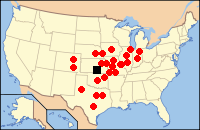
- Omaha & Lincoln, NE
- Des Moines, IA
- Chicago, Springfield and Peoria, IL
- Indianapolis and Ft.Wayne, IN
- Tulsa, Oklahoma City, OK
- Dallas/Ft.Worth, Austin, Lubbock, TX
- Denver and Colorado Springs, CO
Culture:
 Wichita's culture is chiefly blue-collar / industrial (reflecting the large factories that form the economic base of the city),
but also blue-collar/rural (reflecting the cultural roots of most of the population) -- and includes a very large white-collar community, as well (somewhat integrated with the blue-collar community).
Wichita's culture is chiefly blue-collar / industrial (reflecting the large factories that form the economic base of the city),
but also blue-collar/rural (reflecting the cultural roots of most of the population) -- and includes a very large white-collar community, as well (somewhat integrated with the blue-collar community).
(Though blue-collar and more-menial "gray-collar" occupations predominate in Wichita, white-collar occupations abound in Wichita, too. Except for northeast Kansas, Wichita is the state's leading provider of healthcare, legal and financial services, media, education, arts and culture -- as well as employing thousands in other executive, professional and white-collar technical occupations, especially in support of Wichita's major industries).
Wichitans range from hundreds of extraordinarily poor and homeless people, to a few of the world's wealthiest billionaires. Most Wichitans are working-class or upper-middle class.
Until recently, Wichita was normally a city with above-average incomes and below-average unemployment; this has changed since the Bush/Obama recession, the radical Libertarian economics of Governor Brownback's administration, and the growing Libertarian influence of the Koch brothers on politics and economics, state and local. (See "The Koch Effect,", on the POLIITICS page.) Since then, Wichita's economic development, along with the rest of Kansas, has lagged behind the region's recovery.

A sizeable number of Wichitans are union workers (particularly in aircraft manufacturing), though that number continues to dwindle, in this "right-to-work" state, which generally opposes labor unions -- a reflection of the independent-pioneer culture passed down from generations before.
Wichitans commonly pride themselves on a strong work ethic,
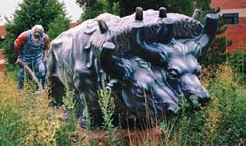 often largely derived from rural/farm heritage. Wichitans tend to be direct and honest, but also generally well-mannered and courteous.
often largely derived from rural/farm heritage. Wichitans tend to be direct and honest, but also generally well-mannered and courteous.
On a personal level, they tend to be more generous than some parts of the nation, but a little less than others. Their politics, however, can be distinctly miserly, as can their businesses.
People coming from large cities on the coasts usually remark that Wichita is exceptionally friendly; people coming from some rural, midwestern and southern states, however, sometimes sense less warmth, here.
Family is extremely important to most Wichitans, and strong family ties are among the chief factors that prevent people leaving the city, or bring them back.
The Lost Families
One important, but fading, aspect of Wichita family life and culture has long been Wichita's "old money" families — founders and heirs of Wichita's leading industrial and commercial enterprises. The giants of industry who built Wichita's economy in the city's first 100 years (1870-1970) had not only been the business leaders of the city, but its cultural and social leaders, and intimate, reliable partners in Wichita's civic and social life.
Most of them had some sense of personal attachment to the city, pride in it's qualities, genuine respect and affection for its people (especially for their workers and workers' families). They invested in Wichita's education, in infrastructure, in religion, charity, arts and entertainment -- not just for themselves, but for the people with whom they shared the city: their neighbors, friends and colleagues, their fellow Wichitans.
These entrepreneurs and leaders — through their business dealings, political activism and philanthropy — shaped much of the environment and culture of Wichita. A rich variety of them kept any one from skewing things awry, and each had a unique and distinctive background that enriched the community they led.
But age, and changes in business and industry, gradually loosened their grip on their community. By the mid-1980s,
nearly all gave up control of their enterprises -- mostly to faceless out-of-state (sometimes out-of-country) corporate conglomerates -- and then died off by the end of the 20th Century, leaving their beloved hometown's fortunes in the hands of distant strangers.
Wichita's fate is now largely in the grip of faraway Wall Street financiers, East-Coast magnates, and foreign corporations -- to whom Wichita is a crude, insignificant, distant backwater, to be efficiently exploited, then avoided, ignored or abandoned. Major employers are no longer like reliable, embracing family, but rather more like cold-hearted adversaries.
The descendants of Wichita's founding merchants, industrialists and financiers still participate in Wichita's life, but with fewer resources, and usually less effect, than their forebears. While the Koch family -- Wichita's last billionaires -- often step up to fill the void, it's usually with a distinctly frosty air, seemingly tainted with cynicism, contempt and ulterior motives.
Schools, parks, and the city's infrastructure, generally, show signs of the indifference of power. Old churches and charities have dried up, and withered away, and some cultural institutions and icons have lost their luster. Public entertainments have become more expensive, and less public -- and the community has lost much of its intimate family feel.
This change in Wichita's economics shows a distinctly dark side of "trickle-down" economics, with less and less trickling down from those who own Wichita, today. And the "every-man-for-himself" values of Wall Street have trickled down to Wichita's Main Street, undermining the egalitarian "let's all pull together" social contract, upon which Wichita's fortunes were built.
City consultants from afar, in recent years, have echoed the complaints of Wichitans of all ages, who say that Wichita needs more human amenities and gathering places, better social and cultural life, and a greater emphasis on quality, rather than quantity, of community, if Wichita is to regain its lost glory and joy. What the consultants neglect to say, is who will bring the necessary leadership, resources and lifelong commitment to Wichita, needed to restore this warm, old "family feel" to Wichita.
A Note About Equality & Diversity
In fairness, it must be noted that the power Wichita's "old families" wielded, sometimes, skewed fortune away from others unfairly. Certainly conservative values dominated their priorities, as the industrial community tends to do, and unfairly discriminatory situations were too-often accommodated, created, even enforced by the city's elite. The poor and minorities were arguably "kept in their place" by many of those in power.
But because the city's economic elite were so numerous and diverse (and even competitive with one another), inevitably there were some who provided aid and precious windows of opportunity to Wichitans on the margins of society, and helped to at least partially relieve Wichita's victims from the nation's long culture of discrimination, segregation and oppression.
Today, orderly corporate systems from afar officially forbid discrimination -- more to avoid lawsuits, and meet government contract quotas, than to truly serve people -- and do little better, than Wichita's old Titans of commerce and industry, at fully and fairly integrating all Wichitans into the economic and social life of the city.
 It's worth noting, too, that Wichita has a more racially integrated culture than most Wichitans realize. Except for African-American and Hispanic minorities, others from diverse backgrounds generally exist in too-small numbers to form large single-ethnicity enclaves and sub-cultures, here, and thus must intermingle and integrate with the community at large.
It's worth noting, too, that Wichita has a more racially integrated culture than most Wichitans realize. Except for African-American and Hispanic minorities, others from diverse backgrounds generally exist in too-small numbers to form large single-ethnicity enclaves and sub-cultures, here, and thus must intermingle and integrate with the community at large.
Even black and brown neighborhoods are diffusing into the wider community since the string of late-20th-Century U.S.Supreme Court decisions — forbidding racial segregation in America — made it harder for white communities and enterprises to keep them away.
Busing to achieve racial integration was instituted in Wichita's Public Schools in the 1970s, and continued until around the turn of the century — creating generations of children, now adults, who had been forced to function in a racially integrated environment. By now, few blue-collar Wichitans alive have grown up purely in racially segregated environments. (Ironically, Wichita's economic elite, despite a presumed intelligence and pretended liberalism of many of them, largely grew up in essentially all-white private schools, and never developed the social skills to interact and integrate well with those of other races and religions).
A national moral growth, resulting from various civil rights movements and religious reforms, have helped smooth the way for Wichita's racial integration. The resulting increasing contact between different races and ethnicities, too, over recent decades, has helped to dispell mistaken assumptions and illusions that created barriers between these diverse elements of Wichita society.
Visitors to Wichita from many other places — rural Kansas, small-town Iowa, the Deep South, even big cities on the East and West coats — often comment on the surprising ease with which races and cultures seem to mix in Wichita.
Ironically, Wichita's white, blue-collar community — deservedly notorious for expressions of bigotry — are more likely to have close friends (even lovers and spouses), of other races, religions and ethnicities, than are Wichita's elite, college-educated, "liberal" immigrants from the coasts. The paradox is quite worth noting, if sometimes inexplicable.
It may be partly due to Wichita being a subculture, itself, that has characteristics shared by all its citizens — characteristics uniting them, and distinguishing them from people of other places — regardless of ethnicity or other characteristics.
For more on Wichita's culture, see AESTHETICS, ARTS & CULTURE section, on the LIVING in WICHITA page.
 Religion:
Religion:
A rich array of religions are practiced here -- most reflecting the city's cultural origins. Conservative and liberal Protestant denominations, and Roman Catholics, predominate. But most other major religions are practiced here as well, plus many smaller denominations. The community includes an Eastern Orthodox cathedral, Muslim mosque, Jewish and Bhuddist temples, and more. Many Wichitans are non-religious, as well.
Wichita is headquarters of the south-central Kansas Roman Catholic diocese, and a center for district or regional leadership, administration and events of other denominations as well.
Wichita's Religious Institutions
In addition to individual congregations and houses of worship, and denominational district offices, Wichita is also home to numerous other religious institutions -- religious, philanthropic and educational -- many of which are major elements of Wichita life, open to all people regardless of religious affiliation. This includes schools, universities, hospitals, charities, shelters and more.
Wichita has about 10-20 religious elementary and secondary schools -- including a massive network of Catholic schools, and several large and small conservative Protestant schools.
All of Wichita's universities began as religious colleges, though all are now open to any student regardless of faith.
-
Wichita State University was founded as Fairmount College by the Congregationalists (Fairmount Congregational Church, nearby) -- the same denomination that founded Harvard, Yale and Vassar. The insitution was soon taken over by city government, then the state.
-
Friends University was founded by the Friends denomination ("Quakers"),
-
Kansas Newman University -- originally Sacred Heart College -- is an institution of the Catholic Church.
(For more on Wichita's schools, colleges and universities, including details about these universities, see the
"EDUCATION"
section of this website's
LIVING page.)
Wichita's three main hospitals
also began as religious institutions:
Via Christi's St. Francis and St. Joseph
hospitals are Catholic institutions, and
Wesley Medical Center
was founded by the Methodist Church, before being sold in the 1980s to a commercial operator.
UPDATE: pre-2020: Via Christi's hospitals were taken over by Ascension, a national chain of commercialized hospitals (mostly current and former Catholic urban hospitals).
Local charity clinics are all founded and/or operated locally by religious denominations (particularly the Catholic Church), including GraceMed, Guadalupe Clinic, Mother Mary Ann Clinic, and others.
A massive Catholic convent (a home for nuns), towers over East Lincoln street, between Hillside and Oliver, just north of St. Joseph hospital (where many of its nuns work), and smaller convents are affiliated with other Catholic facilities in the area, including one on the north side of St. Francis hospital.
Several large religious charitable agencies, particularly from "mainstream" Christian denominations, are a major source of social services in the area. They have become increasingly important in Wichita in recent decades owing to four factors:
-
The loss of local ownership (and thus wealth) of most of Wichita's major companies, to distant owners who care little about Wichita. As the old-money families die off or scatter their wealth among many descendants, less is given to Wichita's secular charities. In particular, the United Way of the Plains (an umbrella charity that collects from workplaces, and distributes to local charities and civic service organizations) has struggled to regain the donor generosity that existed when Wichita's industries fed their wealth to local owners, who gave back to the community that worked for them.
-
The recent-decades' growing emphasis in government, nationwide, on faith-based charities and private philanthropy, as the "preferred" alternative to government charity. This excuse for discontinuing government aid has further eroded Wichitans' public resources -- especially in hard economic times -- forcing them to turn to the private-sector religious institutions.
-
Religious insitutions established as official conduits for government aid. Reagan-era legislation (echoed in the next two presidential administrations and their Congresses) did much to establish faith-based charities as government aid recipients
-- diverting money from secular institutions to religious ones. Consequently, religious charities now control many government-aid resources that once were in secular hands.
-
Increasing need for aid, generally. — the new economic reality of life for Americans (most of whom have seen a decline in their fortunes as libertarian economics has risen to concentrate half of America's wealth in the hands of a microscopic few -- leaving less for the rest of us). In recent years, this has been compounded by the Great Recession, but also particularly in Wichita by the failure of the "Kansas Experiment" -- Libertarian economic practices introduced to local and state government -- which have left Kansas lagging the region, and Wichita lagging the nation, in economic recovery.
Wichita's faith-based charities include this (very incomplete) partial list:
- HumanKind (formerly Interfaith Ministries) (the primary umbrella organization for joint civic and charitable activity of local churches and other religious establishments, mostly of liberal denominations). Prior to becoming HumanKind, Interfaith operated a large complex of housing for the indigent and homeless, and an inner-city clinic. It also provided forums for dialogue between denominations, and attempts to help resolve social issues in the community -- often through political venues.
- Catholic Charities provides a wide range of aid to the indigent, including the free-to-all "Lord's Diner" downtown, and has been particularly active in assisting Indo-Chinese immigrants (Vietnam / Cambodia / Laos).
- United Methodist Urban Ministries has operated a charity clinic and other aid to the poor and homeless, including a food pantry.
- Lutheran Social Services operates an adoption agency
- Episcopal Social Services has operated a shelter for battered women and provided aid for other poor and marginalized people.
- The Salvation Army has long been a major supplier of aid to the homeless and indigent, operates homeless shelters, runs a foster-care orphanage, and recreational facilities for the poor (noted for their "Biddy Basketball" program for poor kids).
- Union Rescue Mission performs similar services.
Note that many of these functions noted above are also performed -- on a smaller scale -- by numerous individual local congregations, of all faiths, operating independently.
Also note, quite importantly, that the nature of many (perhaps most) of these major, long-standing religious charities has changed sharply. Originally, they were mostly volunteer operations, or staffed by very-low-income workers, or individuals accepting only a token salary, and/or operated by religious clerics (particularly Roman Catholic nuns and Protestant ministers).
Today, however, many religious charities have high-dollar personnel: professional administrative and operating staffs — including well-paid, degreed business managers, accountants, "development executives" (fund-raisers), social workers and others. They often consume, as salary, a sizeable percentage of the organization's funds (commonly including extensive government funding, and large contributions from philanthropic foundations or religious denominations, and, increasingly, insurance reimbursements or significant cash payments from clientele). Many have elaborate, custom-built offices and operating faciliities — designed, built and operated at great cost.
For instance, Via Christi's hospital system is chiefly built around St.Francis and St.Joseph hospitals -- two Catholic hospitals originally staffed chiefly by volunteer nuns, who lived in poverty in nearby convents. Today, these hospitals are among the city's foremost employers (and the Via Christi system is normally among the city's top 5 employers in numbers of paid employees). Via Christi owns several city blocks of buildings and facilities, valued at over a billion dollars, and its top executives reportedly command six-figure salaries. Many much-smaller, faith-based, charity clinics and social-services organizations also have numerous staff who collect salaries far, far above the local median income.
(This "professionalizing" of charities is arguably even more true for secular charities, such as the United Way, American Red Cross, various disease and disability associations, and other service organizations, and their facilities).
Wichita's Abortion Battles
Strong conservative Protestant and Catholic sentiment, among many Wichitans, has resulted in exceptionally aggressive conservative social and political action against abortion, here.
In 1986, Wichita pastor Randall Terry formed the nation's leading radical anti-abortion protest group Operation Rescue — which then organized sit-ins and other protests, nationwide, attempting to shut down abortion clinics, and to get public attention and support for their opposition to abortion.
In 1991, Wichita was rocked and deeply divided by the group's often-illegal, but massive, "Summer of Mercy" protests -- aimed mainly at shutting down Wichita's late-term abortion clinic (the most active one in Kansas). The protests, and various acts of civil disobedience or violence, resulted in arrests of over 2,500 protestors, drawing national attention. The physician operating the clinic -- Dr. George Tiller -- was eventually gunned down, in his church, in 2009, by an abortion opponent.
But times change. In late-July, 2016, on the 25th anniversary of the Summer of Mercy,
planned commemorative protests fizzled, and
drew little participation or attention.
Demography vs. Geography
— Who Lives Where:
Like most modern U.S. cities, Wichita has concentrations of certain ethnicities and socio-economic groups in certain parts of the city -- but (again, like most modern cities) these ethnic and socio-economic concentrations are not clear segregations, and all social groups can be found, to some extent, in all parts of the city.
Downtown -- and the adjoining areas to the east (Old Town), and west (Delano) -- until recently, were blighted areas with only a few mostly-poor residents. But these areas have begun a spectacular revival, with a boom in lofts and high-rise apartments, as the city strives to attract "young professionals" to the city's growing downtown.
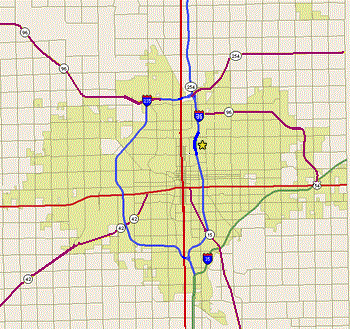 An important demographic divide, in Wichita, is between West and East. Traditionally, East Wichita has been largely white-collar/urban, and West Wichita has been chiefly blue-collar/rural. Some of this division is gradually blurring, particularly as most industrial development moves West, followed by most new housing for both white-collar and blue-collar workers.
Both sides of town are also heavily populated by blue-collar/industrial workers.
An important demographic divide, in Wichita, is between West and East. Traditionally, East Wichita has been largely white-collar/urban, and West Wichita has been chiefly blue-collar/rural. Some of this division is gradually blurring, particularly as most industrial development moves West, followed by most new housing for both white-collar and blue-collar workers.
Both sides of town are also heavily populated by blue-collar/industrial workers.
Here's a generalized summary of Wichita's main districts, clockwise around the map, as marked on the map below:
North-Central Wichita tends to be dominated by racial minorities (north and northeast of downtown, between the Little Arkansas River on the west and Oliver Street to the east. Hispanics concentrate to the North-Northwest, and African-Americans to the North-Northeast). Southeast Asians largely cluster north of downtown, overlapping Hispanic neighborhoods -- but ALL minorities are also widely dispersed throughout the community.
(For the City government's assessement of,
— and vision for — the "Central Northeast" neighborhood, see:
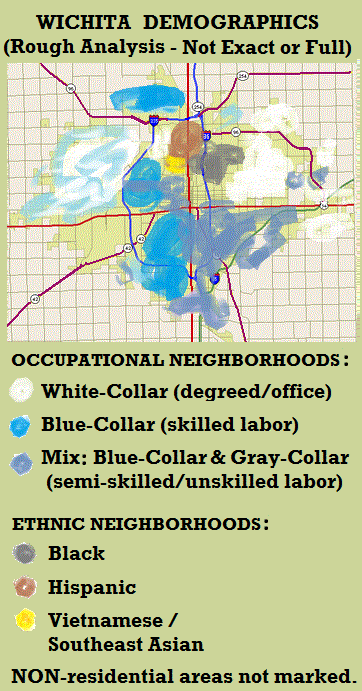
"NorthEast" Wichita is an evolving term. Originally it typically meant the areas north of downtown extending east up to four miles from the center -- an area largely dominated (especially in its inner-city zones) by African-American neighbor-hoods. Over time, however, with the city's expansion eastward, the old "Northeast" area has become increasingly referred to as part of "North-Central."
"NorthEast" is now the term typically applied to the upper-middle-class, and upper-class, white-collar region that starts about 4 ½ miles east of downtown, at about Douglas and Edgemoor, extending outward to the north and east.
Far NorthEast Wichita (e.g.: the Northrock commercial area around K-96 bypass and Rock Road, part of an area originally developed as Comotara), is an area of especially upwardly-mobile entrepreneurs, professionals and advanced-technology workers.
Central-East Wichita (e.g.: College Hill, Eastborough, Vickridge) are largely upper-income white-collar neighborhoods, with the areas in Central-East Wichita largely populated by the city's "old money" families.
(A special note about Eastborough: This enclave of the very rich, between Edgemoor and Rock Road, between Central Ave.and Kellogg, is officially a separate city from Wichita, founded as a refuge for the rich, many decades ago, before the city of Wichita grew to surround it.)
SouthEast Wichita residents, originally mostly white, blue-collar (largely of local and Eastern Kansas, or Eastern U.S., origins), and dominated by aircraft workers, has seen those workers age into retirees, and passing away -- gradually being replaced chiefly by a mix of blue-collar and gray-collar workers, with a growing abundance of racial/ethnic minorities.

South-Central Wichita is largely poor and blue-collar, chiefly of Central Kansas origins, with a noticeable number of minorities, though mostly white.
SouthWest Wichita is Wichita's foremost blue-collar labor supply, manning Wichita factories, machine shops and garages -- though some white-collar, and many gray-collar (menial) workers live here, too.
SouthWest Wichita
is hard-core blue-collar (largely descended from rural/Western/Southern origins - especially Central and Western Kansas, Oklahoma, Texas and Arkansas).
Once an all-white, blue-collar enclave, with Southern roots, it earned a reputation for redneck bigotry. Over time, this has ameliorated somewhat, but Southwest Wichita remains a district largely insensitive to minorities. As racial integration began in Wichita's public schools in the 1960s, many in SouthWest Wichita became "white flight" residents of the suburb of Haysville, three miles south of the city limits, immediately south of Southwest Wichita. The two communities have close ties, and strong cultural similarities.
Central-West Wichita (one of Wichita's oldest communities), like Southwest, is largely blue-collar, and largely of rural origins -- though it is also afflicted with much of the same poverty as South-Central Wichita. Central-West is almost purely white.
Riverside,
in inner-northwest Wichita, northwest of Downtown, straddles the two winding forks of the Arkansas River
-- the Big Arkansas to the west, and the Little Arkansas to the east.
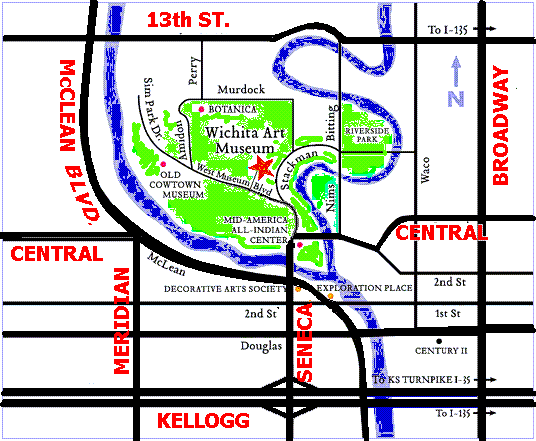
(IMPORTANT NOTE: The Arkansas River is pronounced
"ar-KAN-sas,"
by Kansans
— rather than
"ARK-an-saw"
as it is pronounced in other states).
Riverside is a district of parks and winding scenic parkways. The unusually scenic views (for Wichita), rich vegetation and winding roads of this district yield a distinctively different ambiance and cultural feel from the rest of the city.
People who live in Riverside are a spectacularly diverse mix, mostly white, but of every cultural niche and occupation, from menial to executive -- and more easy-going, as a general rule, than the rest of the city. People here seem to have a more casual attitude towards life (this is where the city's "Bohemian" district flourishes), and lower levels of conflict. Though not entirely liberal, this is a more liberal community than the rest of the city.
"NorthWest" Wichita is an evolving term. Originally, it referred to the region inside the Big Ditch, north of Central Ave. and west of the Riverside area, or any area north of 21st Street on the west side. The Twin Lakes / Sweetbriar shopping centers at 21st & Amidon became the commercial core of that community in the 1960s. That area was typically a blend of white collar and blue collar, with a touch of the flavor of Riverside. Now, however, the term "NorthWest" is sometimes used to refer to "Far NorthWest" Wichita, as well.
Far West and Far NorthWest Wichita are terms often used interchangeably to refer to the newer sections of Wichita that have expanded beyond the Big Ditch and I-235 Bypass around West Wichita. The first of these neighborhoods emerged in the 1950s and 1960s, along Ridge Road, and favored white-collar, middle-class and upper-middle-class whites. A second surge in growth happened in the 1980s and 1990s (still continuing) fueled largely by expansion at Wichita's west-side airport-based aircraft factories. That has brought well-paid and dual-income, blue-collar families into the area, as it has expanded west of Tyler Road -- though the area is also largely white-collar and upper-middle-class.
For a more detailed map of Wichita incomes & neighborhoods, naming individual neighborhood associations and showing their boundaries (with incomes indicated by white/gray/black shading), see:
this large (2.9 MB) City of Wichita JPEG map.
Participate - Let your voice be heard!